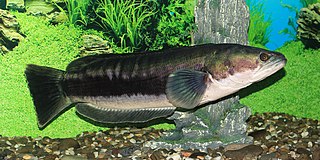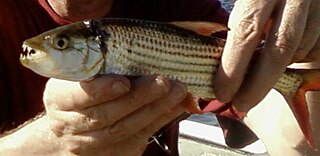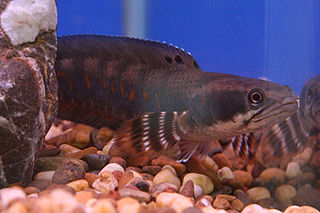
Channa is a genus of predatory fish in the family Channidae, commonly known as snakeheads, native to freshwater habitats in Asia. This genus contains about 50 scientifically described species. The genus has a wide natural distribution extending from Iraq in the west, to Indonesia and China in the east, and parts of Siberia in the Far East. A particularly high richness of species exists in Myanmar (Burma) and northeastern India, and many Channa species live nowhere else. In contrast, a few widespread species have been introduced to several regions outside their natural range, where they often become invasive. The large and medium-sized Channa species are among the most common staple food fish in several Asian countries, and they are extensively cultured. Apart from their importance as a food fish, snakeheads are consumed in some regions as a traditional medicine for wound healing and reducing postoperative pain and discomfort, and collected for the international aquarium pet trade.

The Malabar large-spotted civet, also known as the Malabar civet, is a viverrid endemic to the Western Ghats of India. It is listed as Critically Endangered on the IUCN Red List as the population is estimated to number fewer than 250 mature individuals. It has not been recorded during surveys carried out between 1990 and 2014. In the early 1990s, isolated populations still survived in less disturbed areas of South Malabar but were seriously threatened by habitat destruction and hunting outside protected areas.

The Thamirabarani or Tamraparni or Porunai is a perennial river that originates from the Agastyarkoodam peak of Pothigai hills of the Western Ghats, above Papanasam in the Ambasamudram taluk. It flows through Tirunelveli and Thoothukudi districts of the Tamil Nadu state of southern India into the Gulf of Mannar. It was called the Tamraparni River in the pre-classical period, a name it lent to the island of Sri Lanka. The old Tamil name of the river is Porunai. From the source to sea, the river is about 128 kilometres (80 mi) long and is the only perennial river in Tamil Nadu. This river flows towards north direction initially. However, it changes to east direction later.

The snakeheads are members of the freshwater perciform fish family Channidae, native to parts of Africa and Asia. These elongated, predatory fish are distinguished by their long dorsal fins, large mouths, and shiny teeth. They breathe air with gills, which allows them to migrate short distances over land. They have suprabranchial organs, which are primitive forms of labyrinth organs, that develop when they grow older. The two extant genera are Channa in Asia and Parachanna in Africa, consisting of more than 50 species.
The Borna snakehead, or Chel snakehead, Channa amphibeus, is an extremely rare species of snakehead. C. amphibeus is native only to the Chel River, of the Bhutan foothills, in northern Bengal, India.

Dwarf snakehead is a term coined by aquarists to describe a group of Channa snakehead fishes growing to about 25 cm (10 in) maximum. They are found in freshwater habitats in South and Southeast Asia, and southern China.

The forest snakehead is a species of snakehead, a fish of the family Channidae. Its range includes most of Southeast Asia and parts of southern China. It lives in forest streams and can reach 40 cm (16 in) in length. The forest snakehead is known in Thai language as pla krasong. Khmer language called it កញ្ជនជៃ, Indonesians named it kehung, while in Malaysia, they called it ikan bujuk in Malay Language

Channa gachua, the dwarf snakehead, is a species of fish in the family Channidae. The name "dwarf snakehead" is also used for several other species of small snakeheads. C. gachua is native to freshwater habitats in southern Asia, where it has a wide distribution from Iran to Indonesia. This fish is considered to be a species complex, a group of several closely related taxa with one name. It is likely at least three to four different species, and further research may differentiate them. A few species such as Channa harcourtbutleri have been separated from the complex in recent decades. The easternmost population of C. gachua is often recognized as a separate species C. limbata, while the isolated Sri Lankan population often is recognized as C. kelaartii.

Channa striata, the striped snakehead, is a species of snakehead fish. It is also known as the common snakehead, chevron snakehead, or snakehead murrel and generally referred simply as mudfish. It is native to South and Southeast Asia, and has been introduced to some Pacific Islands. Reports from Madagascar and Hawaii are misidentifications of C. maculata.
Channa harcourtbutleri, the Burmese snakehead, is a species of snakehead endemic to Inle Lake and surroundings in Myanmar. Locally called nga ohn-ma, among aquarists it is considered one of the dwarf snakeheads, but no significant import for aquarists is known. It is one of the smaller species of snakehead and has a standard length of up to 19.4 cm (7.6 in). The specific name honors Sir Harcourt Butler, a British governor in the region.

Channa micropeltes, giant snakehead, giant mudfish or toman harimau, is among the largest species in the family Channidae, capable of growing to 1.5 m (4.9 ft) in length and a weight of 20 kg (44 lb). It is native to the fresh waters of Southeast Asia, but has also been introduced elsewhere, where it can be considered invasive. Other names include xal mas in Assamese, red snakehead, redline snakehead, and ikan toman.

The Ceylon snakehead is a species of snakehead found in freshwater habitats, typically shaded streams, in southwestern Sri Lanka.

Channa marulius is a large species of snakehead native to South Asia. Populations in Southeast Asia are now regarded as separate species.

The blacktip trevally, also known as the blacktip kingfish or yellowtail kingfish, is a species of large marine fish classified in the jack family Carangidae. The blacktip trevally is distributed throughout the tropical to subtropical Indian and West Pacific Oceans, ranging from South Africa in the west to Fiji, Japan and northern Australia in the east. It inhabits coastal waters throughout its range, preferring moderately deep clear waters over rocky and coral reefs. The blacktip trevally is easily distinguished by its yellow fins and a dark upper caudal fin lobe which gives the species its common name, as well as a host of other anatomical features. The species is known to reach a maximum size of 1 m. It is a benthopelagic predator, commonly forming small shoals where it takes a variety of fishes, cephalopods and crustaceans as prey. Little is known of reproduction in the species, and spawning is assumed to take place in more tropical regions of its range, with juveniles known to inhabit bays and large estuaries. Blacktip trevally are often caught using hook and line and various nets in commercial fisheries although don't make up a large part of the market. They are also popular with anglers due to their fighting ability and decent table qualities.
The obscure snakehead, Parachanna obscura, is a medium-sized carnivorous fish that has an elongated shape tapered on both ends and is covered in medium circular scales (cycloid). The head, resembling a snake, is long and depressed anteriorly and covered with cycloid scales slightly larger than those scales on the body. This species is found in central Africa along the western coastline from as far north as Senegal to as far south as Zaire and into central Africa into southwest Sudan.

Hydrocynus forskahlii, the elongate tigerfish, is a species of predatory characin from the family Alestidae which is found in northern and western Africa.

Channa pulchra is a species of snakehead fish in the family Channidae which is native to Myanmar. It was first described in 2007 by R. Britz from a specimen collected from the Kyeintali Chaung (stream) basin in Rakhine Yoma, western Myanmar. The fish is found in streams that are fast flowing, clear, highly oxygenated and relatively cold (subtropical). It is of little food value but getting popularity as an aquarium fish recently.
Channa royi, the Andaman emerald snakehead, is a species of snakehead fish endemic to the Andaman and Nicobar Islands of India. This dwarf snakehead is distinct from other snakehead species due to its differing coloration, number of vertebrae, and teeth, most notably its greenish-gray dorsum. It was only scientifically described in 2018 and its closest relative is the Burmese snakehead, and a review in 2019 argued that the two are synonyms.
Aenigmachanna gollum, the Gollum snakehead, is a species of aquifer-dwelling dragon snakehead fish that is endemic to the Indian state of Kerala.

Channa aurolineata is a species of Asian snakehead in the family Channidae. It is found natively in most of Myanmar's waterways as well as the Mae Khlong drainage in Thailand. There is also an invasive population found in Southeast Florida, United States. This species was recently split from C. marulius, the bullseye snakehead, and confirmed as a separate species in 2018; and the Florida and Thailand populations were not discovered to be C. aurolineata until even more recently in 2019. Before this, the Thailand population's species was unknown and the Florida ones were assumed to be C. marulius. C. aurolineata was able to be separated as a new species and identified in other areas due to slight differences in color pattern, lateral line scale and fin ray morphology, and DNA structure from the other species in the marulius complex.














